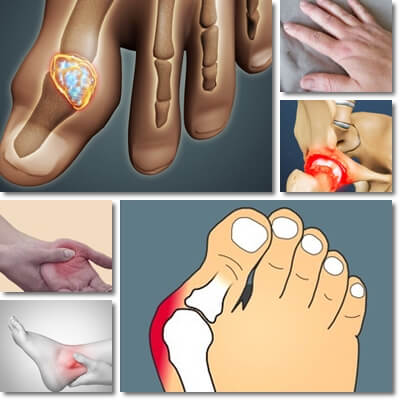Gout is a form of arthritis that causes crystallized uric acid deposits in joints and the tissues around them. The affected joints exhibit symptoms of redness, burning pain and visible swelling. The typical duration of a gout attack ranges from a couple of days to up to two weeks and requires medical treatment to prevent irreversible damage to joints. One or multiple joints may be affected during a gout attack, with the most common area affected being the joint of the big toe. Gout is, for the most part, a genetic condition caused by elevated uric acid levels in the blood, however eating foods high in purines such as mollusks or meat is a major risk factor.
What is gout? Gout is essentially a form of arthritis, an inflammatory condition of the joints. It occurs as a result of higher than normal levels of uric acid in the blood which, over time, cause deposits in joints and the tissues around them. This causes localized swelling and often debilitating pain affecting range of motion and mobility. In time, an untreated gout will lead to irreversible joint damage, bone erosion as well as other health issues, especially kidney stones and kidney failure. Overall, high uric acid levels in the blood are the main cause for gout.

What is uric acid? Uric acid is a byproduct of normal metabolism. It comes from breaking down certain chemicals from food called purines. Under normal circumstances, uric acid is excreted by the kidneys and, to a lesser extent, through the digestive tract. However, there are cases when either too much uric acid is produced by the body or too little is eliminated, resulting in higher than normal levels in the blood. If elevated uric acid levels persist, it can lead to the formation of crystals which tend to deposit in joints and the tissues around them and you get gout. However, some people will have higher than normal levels of uric acid in the blood without getting gout.
What causes gout?
Essentially too much uric acid in the blood or problems eliminating it through the kidneys. Other risk factors include primarily poor dietary habits. Read below to find out the top 10 risk factors for gout:
1) Genetic factors that cause too much uric acid to be produced.
2) Genetic disorders that make the kidneys unable to metabolize and excrete uric acid properly.
3) Having other forms of arthritis or a family history of the condition.
4) Kidney problems that can impact uric acid excretion.
5) Type 2 diabetes and insulin resistance.
6) Other medical conditions: metabolic syndrome, obesity, being overweight, hypertension, high cholesterol, psoriasis, hypothyroidism etc.
7) Sudden and significant weight loss, intended or not, caused by dieting, fasting, starvation or disease.
8) Medicines: diuretics and beta-blockers used for treating hypertension, chemotherapy, psoriasis medication etc.
9) Drinking too much alcohol which decreases the elimination of uric acid through the kidneys.
10) Diet: low carbohydrate-high protein diets, high sugar intake, eating foods rich in purines.
What are purines? Purines are chemicals occurring naturally in food. The human body processes them and breaks them down into uric acid which is then eliminated through the kidneys. Some foods contain more purines than others and eating too much of them can result in high uric acid levels in the blood, creating a predisposition for gout. High-purine foods can also worsen an existing condition and trigger gout attacks. Mussels, sardines, anchovies, shrimp, lobster, game, liver, kidneys and other organ meats are richest in purines and the worst foods you can possibly eat for gout. Alcohol, processed foods, high-sugar foods also raise uric acid levels and cause gout, while eggs, dairy, fruits and vegetables lower risks.

List of symptoms
What are the signs and symptoms you have gout? Gout attacks often occur unexpectedly and are acute in nature, meaning they are characterized by sudden swelling of one or more joints, typically in the lower part of the body, redness, burning pain and impaired mobility. The pain can be so intense it requires medical treatment. Gout attacks are recurrent and may reoccur within the same year, weeks or months apart from each other, or at longer intervals, years apart.
Here are all the possible signs and symptoms and general evolution of gout:
1) Swelling of one or more joints, stiffness, redness, burning sensation, sharp pain.
2) The affected joint is tender to the touch.
3) As the swelling subsides, the skin may become flaky, itchy and peel.
4) Some people experience fever, chills, shivering and fatigue.
5) Gout attacks are known to debut at night, although this is not always the case and are recurrent.
6) An episode may last from as little as 2 days to as long as two weeks if untreated.
7) Symptoms may come on quickly, in a matter of hours.
8) Gout can affect any joint, including those of the toes, fingers, ankle, wrists, knee, elbows.
The most commonly affected joint in gout is the joint of the big toe.
Gout treatment options
The biggest question people with this form of arthritis have is: can you cure gout? Unfortunately, considering the complexity of the condition, you can’t cure gout itself or, better said, you can’t cure gout once and for all. But you can and should treat gout episodes when they occur. This has the benefit of managing the side effects of the joint inflammation and preventing future episodes. Overall, if you have been diagnosed with gout and have already experienced more episodes, then you will probably need treatment for the rest of your life to manage the condition.
Gout treatment will most likely include the following stages:
1) Your doctor will prescribe anti-inflammatory and pain-relieving medication for a gout attack.
2) Other pain-management options may include: using a cold pack for the inflammation and burning pain, elevating the affected joint and resting.
3) Drinking plenty of water is important because it helps the kidneys remove excess uric acid from the blood.
4) Treating underlying conditions that have lead to high levels of uric acid and gout is important.
5) Avoid alcohol, high-purine foods and all forms of processed and high-sugar foods.
Mollusks (mussels, oysters and others), crustaceans (shrimp, prawn, crab, lobster), oily fish (anchovies, herring, mackerel, sardines, tuna, some types of salmon), organ meats (liver, kidneys, hearts, lungs), game (pheasant, rabbit, venison and other) and red meat (pork, beef, veal, mutton, lamb) are extremely high and moderately high in purines and bad foods to eat for gout (read more about the best and worst foods to eat for gout).
A good example of how you can prevent future gout attacks and essentially treat the condition (if it’s not genetic) is to reach a healthy weight which could help treat type 2 diabetes, high blood pressure and high cholesterol, reducing your risk factors for elevated uric acid levels and gout. If you are on medication for either of these conditions, reaching a healthy weight by eating right could mean you would no longer have these conditions and require medicines for them, further reducing your risk factors. Talk to your doctor about how reaching a healthy weight and managing your diet could help you with your gout.
What to eat
Lastly, here are some general guidelines to follow when choosing what foods to eat for gout:
1) Choose foods low in purines: eggs, milk, dairy, fresh fruit, vegetables and whole grains.
2) Look for foods with a high anti-inflammatory value like cherries, sour cherries or vitamin-C rich foods.
3) Choose foods rich in vitamins, minerals and antioxidants, but low and moderately low in calories.
They provide nourishment, but don’t increase body weight.
4) Avoid any form of processed and high-calorie foods. Avoid foods high in refined sugars.
5) Choose complex carbohydrates over simple carbs.
6) Reduce seafood and red meat intake considerably, limit legumes and avoid all three during a gout attack.
It is recommended to limit meat products to 150 g a day and seafood to 1 serving a week, and not from high purine sources.
